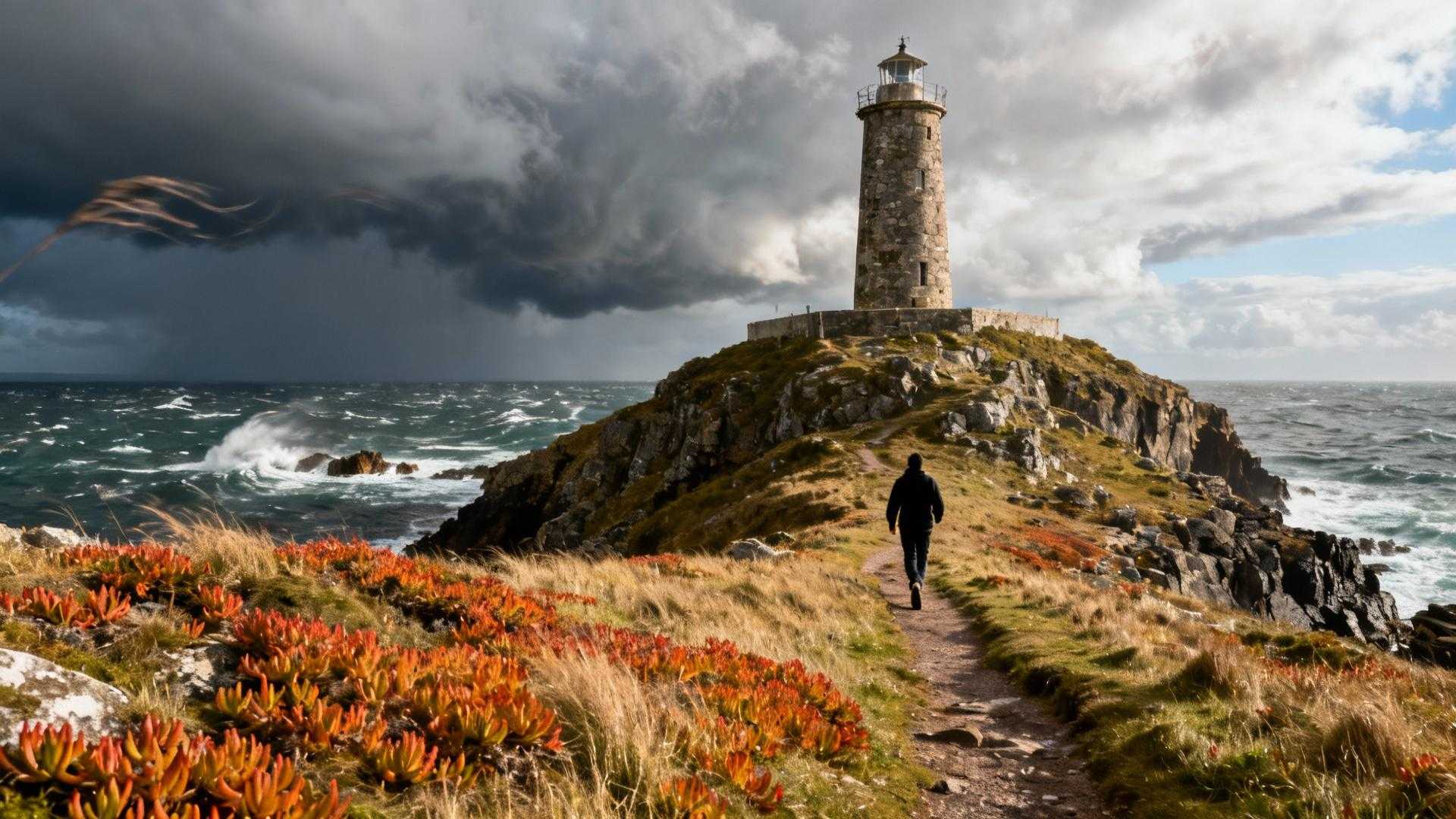The ferry to Fastnet Rock pulls away from Baltimore harbour at dawn, €80 lighter in your wallet. Three hours of Atlantic swells lie ahead for a distant glimpse of Ireland’s most famous lighthouse. Meanwhile, fifteen minutes south of Goleen village, a narrow coastal road leads to Rock Island Point where an 1843 lighthouse stands guard over the Celtic Sea—accessible by foot, visible up close, and completely free.
I discovered this maritime sanctuary while researching Cork’s lighthouse heritage, expecting another tourist-heavy site with entry fees and visitor centers. Instead, Crookhaven Lighthouse revealed itself as everything Fastnet Rock promises but delivers with authentic intimacy. The lighthouse that local sailors fought for in 1838 still stands on its controversial location, surrounded by nine stone cottages that once housed keepers for three lighthouses including Fastnet itself.
The comparison isn’t just about saving €80. It’s about experiencing genuine maritime history without the barriers that mass tourism creates between travelers and the places they visit.
Why Fastnet’s famous tours disappoint more than they deliver
The reality of offshore lighthouse tourism
Fastnet Rock tours operate from Baltimore with weather-dependent schedules that cancel frequently during Atlantic storms. When conditions allow, ninety passengers crowd onto heated ferries for 2.5-hour journeys that spend most time crossing open water. Reviews consistently mention seasickness, brief viewing windows, and the realization that €80 buys mostly travel time rather than lighthouse experience. The rock itself remains inaccessible—you photograph from the boat deck while engines idle.
The hidden costs beyond the ticket price
Factor in Baltimore’s distance from Cork city (90 minutes driving), parking fees, and the full morning commitment that offshore tours demand. Weather cancellations require schedule flexibility that package tourists rarely have. Meanwhile, Crookhaven’s Rock Island Point sits two kilometers from Goleen on roads you’d drive anyway exploring West Cork’s coastal villages. The time investment alone makes land-based lighthouse visits superior for travelers prioritizing authentic experiences over Instagram bragging rights.
What Rock Island Point offers that tour boats can’t
Walking among 180-year-old lighthouse keeper cottages
Nine stone cottages circle Crookhaven Lighthouse, built in the 1860s for the families who maintained this light along with Mizen Head and Fastnet Rock. Now privately owned holiday homes, these structures tell stories of 19th-century maritime life that offshore tours reduce to audio commentary. You can touch the granite walls that George Halpin designed despite local sailors’ protests—they wanted the lighthouse on Alderman’s Rocks, but London headquarters overruled their expertise. That controversy echoes in every stone.
The dramatic setting that rival lighthouses match
Rock Island Point thrusts into Roaring Water Bay with the same wild Atlantic exposure that makes Fastnet famous. The difference? You stand at the base of Crookhaven’s tower feeling October wind carry salt spray across 180-degree ocean views. The coastguard station from 1907 adds historical layers that boat tours simply narrate. This promontory—technically mainland but feeling like an island—served as the southernmost lighthouse station when West India fleets needed navigation and Marconi needed land for transatlantic telegraphy.
The practical advantages that actually matter
Access that doesn’t depend on weather or schedules
Crookhaven waits whenever you arrive. No booking windows, minimum passenger requirements, or cancellation refunds needed. The narrow road to Rock Island Point handles any vehicle, and walking the final approach takes minutes rather than hours. October’s golden light hits the lighthouse at sunset without requiring ferry schedules or tide tables. This flexibility transforms lighthouse visiting from scheduled tourism into spontaneous discovery.
The cultural immersion that offshore tourism erases
Crookhaven village maintains the maritime heritage that this tiny Scottish port village is Britain’s best kept secret celebrates—working harbors where fishing boats still matter more than tourist vessels. The lighthouse pub serves locals who remember when keepers lived in those cottages. Conversations with residents reveal smuggling histories, French invasion attempts in 1796, and why this promontory still guides ships despite GPS. That cultural context enriches lighthouse appreciation in ways that audio guides cannot replicate.
The preservation mindset that protects this experience
Why Cork locals keep this lighthouse low-profile
No visitor center commercializes Rock Island Point because Crookhaven residents value authenticity over tourism revenue. The lighthouse complex remains residential with private holiday cottages that fund preservation without requiring admission fees or gift shops. This community protection explains why you won’t find Rock Island Point featured in mainstream Ireland guides—locals prefer travelers who discover it through research rather than Instagram algorithms.
How to visit respectfully without destroying what makes it special
Park considerately near the village and walk the coastal road to Rock Island Point. Respect private property around the cottages while photographing the lighthouse and Atlantic views. Visit during daylight when the active beacon isn’t operational, similar to I ditched crowded beaches at 30 for this hidden bioluminescent bay discovering that timing enhances experience without disrupting ecosystems. Support Crookhaven’s economy through village pubs and shops rather than expecting lighthouse infrastructure that would compromise its authenticity.
Frequently asked questions about Crookhaven Lighthouse
Can you actually enter Crookhaven Lighthouse?
The lighthouse tower itself remains operational and closed to public access, but the surrounding grounds and coastal approaches offer unrestricted viewing. The nine keeper cottages are private holiday rentals, creating a lived-in authenticity that museum lighthouses lack.
What’s the best time to photograph Rock Island Point?
October through April provides dramatic Atlantic storm light, while May through September offers calmer seas and extended daylight. Sunset from the western approach catches golden light on the limestone tower, and morning visits avoid the rare tourist crowds that summer weekends bring.
How does this compare to other accessible Irish lighthouses?
Unlike we explored 900+ Caribbean islands over 20 years discovering hidden gems, Ireland’s accessible lighthouses typically charge €8-15 admission. Hook Lighthouse in Wexford offers tours but lacks Crookhaven’s intimate scale. Galley Head has a visitor center but more commercial infrastructure. Rock Island Point delivers comparable maritime heritage with zero commercialization and free access that preserves authentic atmosphere.
